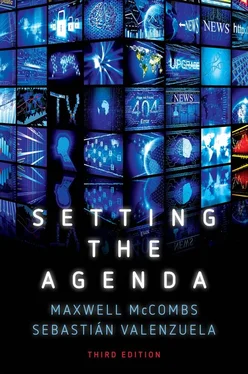All rights reserved. Except for the quotation of short passages for the purpose of criticism and review, no part of this publication may be reproduced, stored in a retrieval system or transmitted, in any form or by any means, electronic, mechanical, photocopying, recording or otherwise, without the prior permission of the publisher.
ISBN-13: 978-1-5095-3579-8 (hardback)
ISBN-13: 978-1-5095-3580-4 (paperback)
A catalogue record for this book is available from the British Library.
Library of Congress Cataloging-in-Publication Data
Names: McCombs, Maxwell E., author. | Valenzuela, Sebastián, author.
Title: Setting the agenda : the news media and public opinion / Maxwell McCombs and Sebastián Valenzuela.
Description: Third edition. | Cambridge, UK ; Medford, MA : Polity Press, 2020. | Includes bibliographical references and index. | Summary: “An anticipated third edition of the go-to text on agenda-setting”-- Provided by publisher.
Identifiers: LCCN 2020017655 (print) | LCCN 2020017656 (ebook) | ISBN 9781509535798 (hardback) | ISBN 9781509535804 (paperback) | ISBN 9781509535811 (epub)
Subjects: LCSH: Mass media and public opinion. | Mass media--Social aspects. | Mass media--Political aspects. | Mass media--Influence. | Public opinion.
Classification: LCC P96.P83 M38 2020 (print) | LCC P96.P83 (ebook) | DDC 302.23--dc23
LC record available at https://lccn.loc.gov/2020017655
LC ebook record available at https://lccn.loc.gov/2020017656
Typeset in 10.5 on 12pt Plantin
by Fakenham Prepress Solutions, Fakenham, Norfolk NR21 8NL
Printed and bound in Great Britain by TJ International Limited
The publisher has used its best endeavours to ensure that the URLs for external websites referred to in this book are correct and active at the time of going to press. However, the publisher has no responsibility for the websites and can make no guarantee that a site will remain live or that the content is or will remain appropriate.
Every effort has been made to trace all copyright holders, but if any have been overlooked the publisher will be pleased to include any necessary credits in any subsequent reprint or edition.
For further information on Polity, visit our website: politybooks.com
1.1 Agenda-setting role of the news media
1.2 The power of the news
2.1 Newspaper coverage and public concern about crime
2.2 The Acapulco typology: four perspectives on agenda setting
3.1 First- and second-level agenda setting
3.2 Attribute agenda setting in Spanish local elections
3.3 Compelling arguments: Another path for the transfer of salience between the media agenda and the public agenda
4.1 Matrix of candidate attributes
4.2 Media and public attribute agenda networks
5.1 Need for orientation and agenda-setting effects
5.2 Need for orientation and average level of interest in political information
5.3 Agenda-setting effects for obtrusive and unobtrusive issues (natural history perspective)
5.4 Agenda-setting effects for obtrusive and unobtrusive issues (competition perspective)
6.1 Duration of major issues on the public agenda
6.2 A comparison of attribute agenda-setting effects based on three measures of attribute salience among the public for an environmental issue
7.1 An expanded view of agenda setting
7.2 A metaphorical onion of the media agenda
8.1 Consequences of agenda setting
8.2 Individual behaviour in response to news of plane crashes and skyjackings
8.3 Impact on three behaviours of object salience on the media agenda
9.1 Patterns of social consensus with increasing use of the news media among demographic groups in Spain, Taiwan, and the United States
Foreword: ‘Messages and Residues’
Even as children we know instinctively that a message, such as a cry, generates a response. This comprehensive book makes clear that many messages, especially those from news media, are not random but are ordered by journalists and others in prioritized ways, from most to least important, and that audiences have to read, watch, listen, and learn. Agendas provide priorities, not just information.
In our personal lives we live in real worlds with family and friends and street addresses, jobs, schools, and hospitals, and deserts and mountains. In our civic lives we live in imagined worlds that we learn about from others, including media. These worlds overlap, of course. There is a continuum from touching to visualizing. Information from others, including traditional and social media, providing prioritized agendas. In media the priorities are evident. Newspapers give the biggest headline to the most important topic, a presidential election result, or a tearing tornado. Television leads off with the topic, or even breaks into regular programming with ‘breaking news’. Social media lead off with the topic and stay on that topic, gathering others into the informational web like an expanding spiderweb in the attic.
Agenda setting is often described as the press telling us what to think about rather than what to think. We have long known that media coverage can magnify topics, or even people, as P. T. Barnum in the nineteenth century made an apparently good singer, Jenny Lind, into a world-famous star, the Swedish Nightingale. The power of a message, or an amplified voice one way or the other, has been known for centuries, but agenda-setting scholars have provided specific evidence of the many ways this phenomenon occurs – across time, nationalities, and political systems. Communication scholars Maxwell McCombs and Sebastián Valenzuela have surveyed a vast literature in a single volume in a way that teachers and scholars can use. This is a text and a major book of scholarship.
Agenda-setting scholarship was a long time in coming. Wilbur Schramm of Stanford more or less invented the field of mass communication scholarship seventy years ago with his own writing and collections of key insights about media and mass communication. These collections served as early texts and research guides. Scholars of journalism conducted legal and historical scholarship in the first years (as they still do) and borrowed the methods of sociology and social psychology. They also employed content analysis, the one method that naturally belongs to journalism scholarship. Decades ago, Wayne Danielson of Stanford, North Carolina, and Texas, and Guido Stempel of Ohio University, among others, began to link content with computers and find ways to generalize research samples to large populations. Schramm early on sketched a model of a communicator-to-message-to-audience message direction, with a weaker feedback loop. It was, and remains, a universe to discover.
With content analysis, one could read messages backwards to discern details of audiences and even cultures, but also could look forward more precisely at effects on audiences. Of course, there was the message itself. The agenda-setting work of McCombs and his colleagues connected content analysis with audience effects more exactly than ever before. One could make predictions, the first step in theory building. If we had time and resources, we could trace historically how the voice of a Swedish singer grew from filling auditoriums in towns and cities to filling the imagined air of listeners everywhere, with echoes even today, more than a century later. Agendas leave residues. Agenda setting provides tools as well as concepts. Agenda setting goes forwards and backwards, even as we stand, so to speak, on messages themselves.
Citation analysis of the original article of McCombs and Donald Shaw demonstrates the growth in the concept of agenda setting, along with the resistance to the simple idea it represented – if a cognitive stimulus, then a cognitive response – in a period, the 1950s and 1960s, when attitude change was the dominant paradigm. We remember reading one literature review which detailed this resistance like the lines left by the receding tides on an Atlantic beach, from: (1) there is no message residue, to (2) there is a slight, but artifactual, residue, to (3) there is a residue, but we have long known about it, to (4) there is a message effect but it’s mostly trivial and can be accounted for by other causes. That is, the review hinted, agenda-setting research is not significant, at least to those most interested in attitude change and behaviour. The first paper on agenda setting, based on the 1968 presidential election study in Chapel Hill, was rejected by the Association for Education in Journalism (now AEJMC). It was not published until 1972, slightly revised, in Public Opinion Quarterly.
Читать дальше












